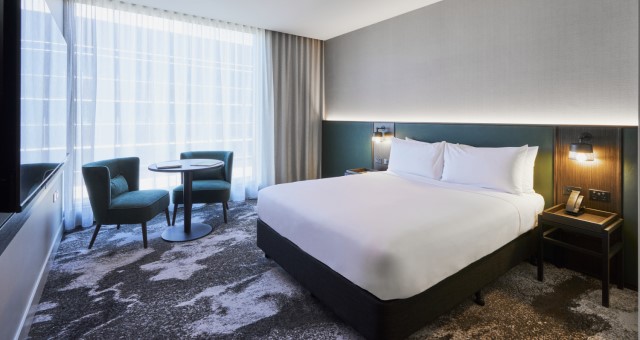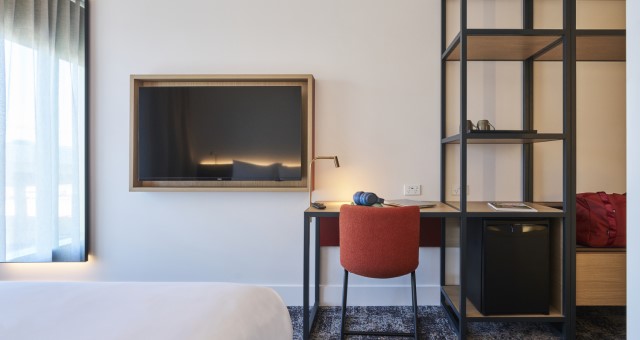Melbourne Airport has welcomed the arrival of its first internationally branded new-build hotel in over two decades with the opening of the dual-branded Novotel and Ibis Styles Melbourne Airport on Monday.
Over 120 key industry and media stakeholders were in attendance for the official ribbon cutting and launch event led by Melbourne Airport CEO Lorie Argus, Accor Pacific Chief Operating Officer, Adrian Williams and Visit Victoria CEO Brendan McClement, with guests invited to explore the hotel’s expansive accommodation and facilities on offer.

The AU$230 million project, which was eight years in the making, represents the largest and most significant hotel development in Australia this year and is the cumulation of construction, architecture and design works by the teams at Built, Fender Katsalidis, Techne and Woods Bagot.
With over 100,000 passengers passing through the airport each day, Melbourne Airport CEO Lorie Argus said the hotel will play an important role in serving the growing number of travellers.
“Melbourne Airport is growing; we were the first major airport in the country to reach pre-pandemic levels for international capacity and domestic capacity, and we are over 100% of traffic,” Argus said.
“By 2042, we expect to be at 76 million passengers coming through our doors and we’re investing now to make sure that the facilities keep up with that.

“As Victoria’s gateway to the world and the best airport in Australia and the Pacific, as voted by our passengers, these new hotels will enable us to meet the future demand and the growing passenger base.”
‘More than just a place to sleep’
Located within the Melbourne Airport precinct, a short walk or shuttle bus to the various terminals, the dual-branded hotel features 464 guest rooms – 248 of which have been designed under Accor’s midscale Novotel brand and 216 under its design-driven economy brand Ibis Styles.
“The vision here is to have two brands so that we’ve got options for a range of travellers,” Accor Pacific Chief Operating Officer Adrian Williams told HM.
With 22 airport hotels across the Pacific, Accor is committed to redefining the experience in this category to serve not just travellers, but entire communities.
“Airport hotels have always been a strong category and with the continued growth of international and domestic tourism, it’s the place to be – and not just for travellers,” he said.
“The Melbourne Airport precinct really is a mini city, with 20,000 workers out here, there’s many other things going on beyond air travel.”
The hotel caters to business, conference, and leisure guests alike with ample facilities including three dining venues, two floors of hotel-serviced co-working space – a first for the airport – the largest function space in the precinct, catering to up to 330 guests, as well as the city’s first airport health and wellbeing facility.
Williams says it’s “much more than just a place to sleep”.
“What we’ve seen is a real demand for great experiences,” he told HM.
“People, whether they are travelling or working at an airport, are looking for a range of things: great food, amazing accommodation, a value-oriented experience.
A celebration of Victoria
The hotel’s design was inspired by the state of Victoria with nods to the region’s natural splendour throughout.
On arrival, guests cross over a bluestone path – reminiscent of Melbourne’s iconic laneways – flanked by a leafy courtyard, that leads into a grand foyer with a reception desk for each brand, as well as three digital kiosks for a quick and convenient check-in/check-out.
Digital screens thoughtfully positioned throughout the public spaces list up-to-date flight information to allow guests to maximise their time in a relaxed hotel environment and reduce waiting time in the hustle and bustle of the terminal.
A calming colour palette of natural shades of green, sand and charcoal extends from the lobby and conference spaces – where carpets are inspired by the scenery of the Great Ocean Road – through to the Novotel guest rooms.
On exiting the lift, guests are greeted by the “changing faces of Melbourne” a selection of portraits of young and old Melbournians, that represents the city’s diverse population.
The design-driven Ibis Styles brand comes to life in 216 rooms over nine levels with a playful, urban look that echoes Melbourne’s arts and culture scene.
Carpet in the corridor is inspired by the original design of Melbourne’s Hoddle (street) Grid – and doubles up as a Spiderman effect for the younger guests as Director of Sales and Marketing Narelle Welsh points out.
Standing at 21sqm, the Ibis Styles guest rooms feature industrial-style fixtures and fittings, coloured grout in the shower and a striking statement wall behind the bed that features one of seven themed decals.
“Narelle tells me, ‘it’s Gen Z that way and corporate and calming that way’,” Argus told guests, pointing to opposite ends of the lobby.
The hotel’s food and beverage offering includes Small Holdings café, which welcomes a steady trail of guests and local workers for coffee and pastries throughout the day; Boccata Restaurant, which serves up a buffet breakfast in the mornings before transitioning to an Italian restaurant in the evenings; and modern gastropub, Amber State Taphouse and Kitchen, which is slated to open in the spring.
Visit Victoria CEO Brendan McClements, described the hotel as a “fantastic addition” to Melbourne and told those gathered that the opening represents a “great day for the visitor economy”.
“We have ambitions as a state to grow our visitor economy from what was a record AU$39.3 billion at the end of March to something closer to AU$54 billion in 2028,” McClements said.
“To do that, we need 15,000 more visitors a night to come to Melbourne, so we need more hotel rooms; we need more people; we need more planes.”








